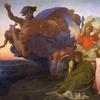THEATER OF WAR: Paul Endres Jr.'s Tales of the American Burden
- BOSTON, Massachusetts
- /
- April 07, 2014
On Exhibit at Childs Gallery, Boston, April 10th - June 14th.
Named one of the Boston Globe’s “Five young artists to watch” in 2011, painter Paul Endres Jr. continues to enthrall with his hyper-real vision of an absurdist post-apocalyptic world.
“Being a painter in the 21st century is so contradictory,” muses 28-year-old artist Paul Endres Jr. “Painting is an old world craft in a faster and faster moving digital world. My work combines that venerable notion of painting with contemporary cultural imagery.”
Also a dichotomy is the theme of the artist’s exhilarating new exhibition at Childs Gallery: the marriage of epic storytelling and formal subversion. Collectively known as the “American Burden,” the monumental - and entertaining - series depicts a single sprawling narrative that jumps back and forth in time. Setting everything in motion is an unexplained cataclysmic event that has occurred “off-screen,” says the writer/artist. The world as we know it, and most certainly Boston, are forever changed. Endres satirically mythologizes the aftermath: a nation of activists, pawns, and innocents forced to do battle with supernatural forces.
Despite a fondness for the absurd and a wry sense of humor, Endres makes it impossible to dismiss his work as merely a clever – albeit masterfully painted - riff on comic book superheroes and science fiction fantasy. As a scholar of Western literature and art history, the Bostonian is contemporary artist as Renaissance man, informing his apocalyptic themed work with wide-ranging literary and artistic references: Caravaggio and Goya, Copley and Sargent, Picasso and Guston, Homer, Dante and Joyce. Like those celebrated artists, Endres conveys an earnest believability in his imagined new world order that echoes Anton Chekhov’s oft-quoted sentiment: “We should show life neither as it is nor as it ought to be, but as we see it in our dreams.”
Endres has been dreaming about epic storytelling since childhood. The family dinner hour often included pop quizzes about pivotal historic events, cheerfully administered by his former American history teacher father. Paul was far less enthused, however, when studying larger-than-life reinterpretations of heroism by famous genre painters.
“Take [Emanuel] Leutze’s Washington Crossing the Delaware,” Endres animatedly explains. “That painting is so famous it has become how we all view the actual event. But it’s all wrong. Washington shouldn’t be standing, there are too many people in the boat, and the flag design didn’t exist until two years later. As a kid, I was so miffed that it wasn’t correct. Then later in my own work, I decided to absorb the absurdity of historical inaccuracies in artwork and actually make that a key element.”
Large scale, history-as-morality-tale paintings also taught Endres how to breathe life into dramatic visual narrative through scenic structure, character placement, and manipulated perspective. As an example he cites The Death of General Wolfe (1770) by Benjamin West, and the grandiose canvases of Jacques-Louis David, “a brilliant neo-classical painter, but such a propagandist!”
Endres pays tribute to many of the artists who have inspired him, both in visuals and in storytelling. Iconic images from Picasso’s Guernica (1937) and Gilbert Stuart’s famous portrait of George Washington (1805) become geopolitical costume emblems; and a little girl’s dress depicted in John Singer Sargent’s The Daughters of Edward Darley Boit (1882) serves as a metaphor for an unwitting child’s innocence.
As for the artist’s fantastical time-challenged narrative, James Joyce proved most influential, particularly his Ulysses (1922). “History is a nightmare from which I am trying to awake,” says Joyce’s fictional alter ego Stephen Dedalus, a teacher burdened by historic acts of violence and their resultant chaos. Also the title character in A Portrait of the Artist as a Young Man (1916), Dedalus is but one of Joyce’s recurring characters that pop in and out of his novels. “That allows the audience to develop a relationship with these characters over time,” explains Endres, who draws a direct line from Joyce’s Ulysses to superhero comic books to Star Wars and digital graphic novels.
“One doesn’t discredit the other,” he adds. “Absurdity is a big part of my work. There’s a seriousness about the characters in search of a relic, a superhero’s severed head that retains power. But there is a ridiculousness in believing this is a true story. I like that double-edged sword of frightening apocalypse and humor in the situation.
“Like Joyce, I have respect for all my characters while pointing out their foibles. They are all super-flawed people. My family, wife and friends have become the models for ongoing central characters.” Wife Colleen, herself an artist and trusted sounding board, portrays Abigail Daedalus. (Yes, Endres is Stephen.) Wrapped in a dress of bright yellow caution tape, she defiantly stares down the viewer in “Abigail Readies for War,” an indomitable Wonder Woman for the 21st century.
“I am always the main villain,” says Endres, “like Philip Guston putting himself in the Klan hood. I wouldn’t ask anyone else to step into that role.” Unlike Guston, however, Endres is not working out any demons through his art. He enjoys every minute of the lengthy preparation process.
“I start with an idea of what the event will be, like the First Battle of Copley Square. I make all the props, make the costumes, or research costumes to buy online. Then comes the casting call.” Endres is quick to take advantage of family outings or a reunion weekend with friends from high school, but he is also careful not to try anyone’s patience. His preparatory sketches are so detailed that the costumed photo shoots take under 10 minutes. Even in that short amount of time, they draw large crowds of mystified passers-by.
Specificity to Boston is a key element for Endres who has made dramatic usage of the John Hancock Tower, Kenmore Square Citgo sign (renamed for the all-powerful Ocampo), Newbury Street, and Storrow Drive road signs. It has a similar effect to seeing the beached Statue of Liberty at the end of Planet of the Apes, revealing that the movie’s horrific upside-down world is actually New York City.
Once Endres has the staged character photograph on his computer, he props his painter’s palette on top of the keyboard as a color guide while photoshopping added scenic elements and larger-than-life figures, like a defeated Colossus. The result is an elaborate digital collage from which he finally begins to paint, using oil on panel. This method is both an ode to 19th century history painting and a concession to his work process. “Oil gives you a longer working window than today’s acrylics and I like the rigidness of the panel. I lean in very close to paint faces in detail and canvases are less sturdy and easier to accidently damage.”
Cate McQuaid of the Boston Globe named Endres one of Boston’s “Five young artists to watch” in 2011. She writes, “His work examines how history painting as a genre shapes national mythologies, and how slippery history can be,” later describing his finished work as “HD-crisp and often jam-packed with characters, comedy, and violence.”
That is what intrigued Childs Gallery President Richard Baiano when first introduced to the artist’s work. “Paul masterfully comingles old world art with modern technology and new media. When you look at his paintings, you admire them for their skilled craft and engaging narrative, while having no clue as to the complicated thought process and painstaking preparation involved. We saw it firsthand when he painted our staff and co-workers into the “American Burden” mythology.
“And he never caricatures or makes fun of his volunteer ‘actors’. Whether heroic, villainous, frightened, or angry, each retains his or her humanity. The result is an earnest believability in this bizarre, complicated, and often comical new world.”
Adding to viewers’ enjoyment, Childs Gallery provides detailed wall copy to accompany the show, including an “American Burden” timeline and individual character histories.
Paul Endres Jr. will make a personal appearance at Childs Gallery on Thursday, April 10th between 6:00 and 8:00 P.M. The public is welcome. The exhibition will be online after the opening www.childsgallery.com
Contact:
Stephanie BondChilds Gallery
6172661108
stephanie@childsgallery.com












100x100_c.jpg)

![Offering a Truce [Bested], 1895, is estimated to sell for between $1,300,000 and $1,800,000 on March 22, 2014, for The Russell: An Exhibition and Sale to Benefit the C.M. Russell Museum. Offering a Truce [Bested], 1895, is estimated to sell for between $1,300,000 and $1,800,000 on March 22, 2014, for The Russell: An Exhibition and Sale to Benefit the C.M. Russell Museum.](/images/c/a8/20/Dec10_Offering_a_Truce__Bested_300dpi100x100_c.jpg)